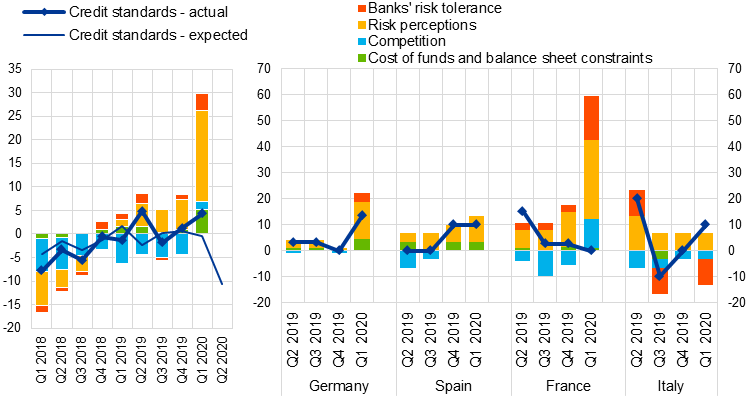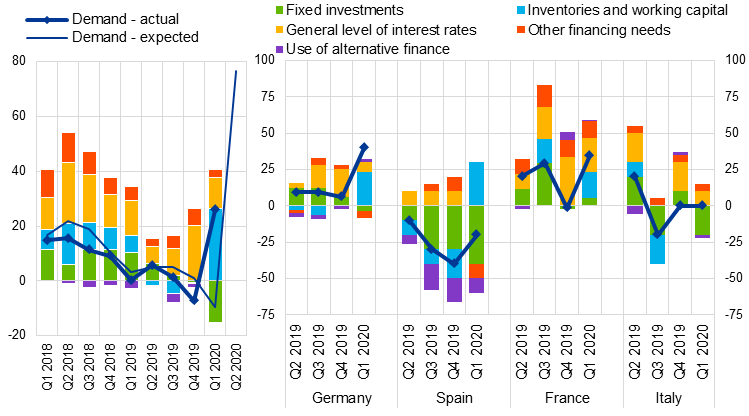- PRESS RELEASE
- 28 April 2020
April 2020 euro area bank lending survey
- Tighter credit standards for loans to enterprises and households
- Surge in firms’ demand for loans due to coronavirus pandemic emergency liquidity needs
- Bank lending conditions ease with ECB’s targeted longer-term refinancing operations
- ECB’s asset purchases support banks’ liquidity positions and market financing conditions
Credit standards – i.e. banks’ internal guidelines or loan approval criteria – tightened for loans to enterprises, loans to households for house purchase and consumer credit and other lending to households in the first quarter of 2020, according to the April 2020 bank lending survey (BLS). The net percentage of banks reporting a tightening of credit standards for loans or credit lines to firms was contained (net percentage of banks at 4%, see Chart 1). This is related to the size and timeliness of policy measures and the higher resilience of euro area banks. For loans to households, the net tightening was somewhat stronger than for firms (a net percentage of 9% for loans to households for house purchase and of 10% for consumer credit and other lending to households). Banks referred to the deterioration of the general economic outlook, increased credit risk of borrowers and a lower risk tolerance as relevant factors for the tightening of their credit standards for loans to firms and households.
For the second quarter of 2020, banks expect credit standards to ease considerably for firms, probably on account of the support measures introduced by governments. At the same time, the dispersion in replies highlights the high uncertainty surrounding the likely impact of the coronavirus (COVID-19) pandemic and the different views of banks on the impact on bank lending conditions. By contrast, the net tightening of credit standards on loans to households is expected to continue in the second quarter of 2020.
Banks’ overall terms and conditions – i.e. the actual terms and conditions agreed in loan contracts – tightened in the first quarter of 2020 for new loans to enterprises, on account of wider loan margins, collateral requirements and other terms and conditions. For new loans to households, the net tightening of banks’ overall terms and conditions was small in the first quarter of 2020.
Firms’ demand for loans or drawing of credit lines surged in the first quarter of 2020, on account of their emergency liquidity needs in the context of the coronavirus pandemic (see Chart 2). Loan demand was significantly higher for short-term loans than for long-term loans, in line with firms’ ongoing payment needs, while financing needs for fixed investment and for mergers and acquisitions declined in net terms. The net percentage of banks reporting an increase in demand for housing loans declined in the first quarter of 2020 and the net percentage relating to the demand for consumer credit and other lending to households turned negative. Net demand for housing loans and consumer credit was supported by the low general level of interest rates but dampened by weak consumer confidence.
Banks expect that net demand for loans to firms will increase further in the second quarter of 2020. A strongly negative net balance for demand for housing loans and consumer credit is expected by banks in the second quarter of 2020.
Regarding the impact of the ECB’s monetary policy measures, its asset purchase programme, pandemic emergency purchase programme and third series of targeted longer-term refinancing operations have had a positive impact on banks’ liquidity positions and market financing conditions. In addition, these measures and the negative deposit facility rate have had an easing impact on bank lending conditions and a positive impact on lending volumes. At the same time, the ECB’s asset purchases and the negative rate on the deposit facility are assessed by banks as having a negative impact on their profitability through a negative impact on their net interest income, while a large percentage of banks report that the ECB’s two-tier system for remunerating excess liquidity holdings supports bank profitability.
The euro area bank lending survey, which is conducted four times a year, was developed by the Eurosystem in order to improve its understanding of banks’ lending behaviour in the euro area. The results reported in the April 2020 survey relate to changes observed in the first quarter of 2020 and expected changes in the second quarter of 2020, unless otherwise indicated. The April 2020 survey round was conducted between 19 March and 3 April 2020. A total of 144 banks were surveyed in this round, with a response rate of 99%.
For media queries, please contact Eva Taylor, tel.: +49 69 1344 7162.
Notes
- A report on this survey round is available at https://www.ecb.europa.eu/stats/ecb_surveys/bank_lending_survey/html/index.en.html. A copy of the questionnaire, a glossary of BLS terms and a BLS user guide with information on the BLS series keys can also be found on that web page.
- The euro area and national data series are available on the ECB’s website via the Statistical Data Warehouse (http://sdw.ecb.europa.eu/browse.do?node=9691151). National results, as published by the respective national central banks, can be obtained via https://www.ecb.europa.eu/stats/ecb_surveys/bank_lending_survey/html/index.en.html.
- For more detailed information on the bank lending survey, see Köhler-Ulbrich, P., Hempell, H. and Scopel, S., “The euro area bank lending survey”, Occasional Paper Series, No 179, ECB, 2016 (http://www.ecb.europa.eu/pub/pdf/scpops/ecbop179.en.pdf).
Changes in credit standards for loans or credit lines to enterprises and contributing factors
(net percentages of banks reporting a tightening of credit standards and contributing factors)

Source: ECB (BLS).
Notes: Net percentages are defined as the difference between the sum of the percentages of banks responding “tightened considerably” and “tightened somewhat” and the sum of the percentages of banks responding “eased somewhat” and “eased considerably”.
Changes in demand for loans or credit lines to enterprises and contributing factors
(net percentages of banks reporting an increase in demand and contributing factors)

Source: ECB (BLS).
Notes: Net percentages for the questions on demand for loans are defined as the difference between the sum of the percentages of banks responding “increased considerably” and “increased somewhat” and the sum of the percentages of banks responding “decreased somewhat” and “decreased considerably”.
European Central Bank
Directorate General Communications
- Sonnemannstrasse 20
- 60314 Frankfurt am Main, Germany
- +49 69 1344 7455
- media@ecb.europa.eu
Reproduction is permitted provided that the source is acknowledged.
Media contacts

